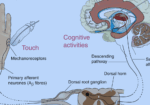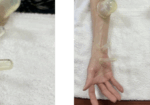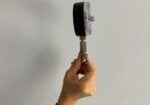Carpal Tunnel Treatment: Splinting Only vs Splinting & Conservative Treatment
Filed under Treatments
Short-term clinical outcome of orthosis alone vs combination of orthosis, nerve, and tendon gliding exercises and ultrasound therapy for treatment of carpal tunnel syndrome. Sim, Sze En et al. Journal of Hand Therapy, Volume 32, Issue 4, 411 – 416
The Skinny- Carpal tunnel syndrome (CTS) is the most common compression neuropathy. Compression of the Median nerve within the transverse carpal ligament causes tingling and numbness to areas distal to the compression and along the nerve distribution area. This can progress to pain and loss of muscle mass if left untreated. Treatment of CTS varies, but commonly includes use of an orthosis to decrease pressure to the carpal tunnel and preserve blood supply to the area. Modalities have also been used with success. These include, but are not limited to, nerve and tendon glides, ultrasound and manual therapy. This article sought to compare the success of orthosis use alone versus orthosis use combined with carpal tunnel syndrome conservative treatment methods.
In The Weeds- 41 total patients with 56 wrists were randomly allocated to the orthosis only (n=20) vs combined (n=21) groups. Pre and post assessments were conducted using the Boston Carpal Tunnel Questionnaire (BCTQ). Post assessment occurred after 2 months, immediately at removal of orthosis protocol.
Orthoses were volar wrist cock up made custom from thermoplastic by a trained occupational therapist. Pt’s were to wear the orthoses for 8 weeks and only allowed to come out of carpal tunnel orthosis for 1 hour per day. Adjustments were made as needed based on discomfort. The Combined group used the same orthosis parameters but added in the use of weekly ultrasound for 5 minutes as well as nerve and tendon gliding exercises for 10 repetitions and 10 sessions per day.
Bring it Home- Analysis of the two groups showed statistically significant improvement in Symptom Severity Score (SSS) as well as Functional Status Score (FSS). There was not, however, a statistical significance on outcomes between groups. This is in contrast to other articles (Baysal et al) which demonstrate a significant difference between orthosis alone and orthosis and conservative therapy.
The outcomes contradict the hypothesis of the authors. They admit the limitations of their study include the use of exercises that did not replicate their model study as well as a lack of follow up at another interval after cessation of orthosis use at the 8 week mark. Symptom decrease with orthosis use only might not be sustainable without the conservative treatment to promote healthy motion moving forward. This would be identifiable with additional follow up after the 8 week mark.
It is also unclear if the participants in the Orthosis Only group had regular follow-ups during the 8 weeks for splint modification (splint for carpal tunnel occupational therapy) or compliance check-in. This return frequency would not necessarily directly replicate clinical application of an orthosis only treatment plan.
Baysal, O., Altay, Z., Ozcan, C., Ertem, K., Yologlu, S., & Kayhan, A. (2006). Comparison of three conservative treatment protocols in carpal tunnel syndrome. International journal of clinical practice, 60(7), 820-828.
More To Read
Peripheral nerve injury: A hand therapist’s assessment of sensory return.
Sensory return after a hand injury specifically a peripheral nerve injury After a peripheral nerve injury, there are often times impairments in sensory function and/or motor function. The rate of recovery varies based on the degree of injury, the overall health of the patient, and the patient’s age. After an injury, it is important…
Read MoreTherapeutic Interventions and Contraindications of Cupping
By Kaylen Kallander Cupping therapy is used to apply negative pressure to a localized area of muscular or neurological pain to relieve nerve pressure and increase blood flow to an affected area. This modality is commonly used for athletes, but is also a frequent treatment in physical therapy, occupational therapy, or hand therapy. While cupping…
Read MoreStretching After Stroke for Spasticity
Rapid Review By: Mikayla Murphy Kerr, L., Jewell, V. D., & Jensen, L. (2020). Stretching and splinting interventions for post stroke spasticity, hand function, and functional tasks: A systematic review. American Journal of Occupational Therapy, 74, 7405205050. https://doi.org/10.5014/ajot.2020.029454 The Skinny This study focused on the benefits of stretching the upper extremity to decrease spasticity, increase…
Read MoreArticle Review: Trapeziectomy and LRTI: What can patients with CMC osteoarthritis expect 12 months after the procedure?
Janakiramanan, N., Miles, O., Collon, S., Crammond, B., McCombe, D., & Tham, S. K. (2021). Functional Recovery Following Trapeziectomy and Ligament Reconstruction and Tendon Interposition (Trapeziectomy and LRTI): A Prospective Longitudinal Study. The Journal of hand surgery, S0363-5023(21)00304-X. Advance online publication. https://doi.org/10.1016/j.jhsa.2021.04.036 The skinny: Patients with trapeziometacarpal (TMC) osteoarthritis who are candidates for a trapeziectomy and…
Read MoreSign-up to Get Updates Straight to Your Inbox!
Sign up with us and we will send you regular blog posts on everything hand therapy, notices every time we upload new videos and tutorials, along with handout, protocols, and other useful information.






